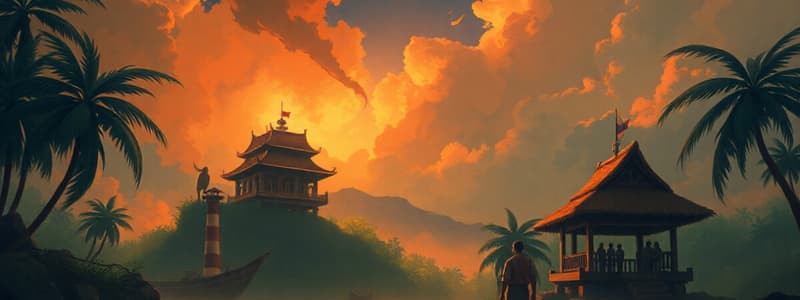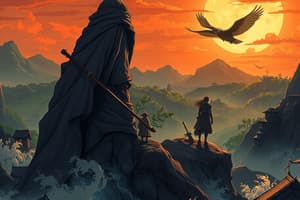Podcast
Questions and Answers
What two books were considered two of the earliest printed books in the Philippines?
What two books were considered two of the earliest printed books in the Philippines?
- Sampaguitas y poesias varias by Modesto de Castro and Urbana at Felisa by Pedro Paterno
- A Child of Sorrow by Zoilo M. Galang and His Native Soil by Juan C. Laya
- The Christian Doctrine and Doctrina Cristiana (correct)
- Nuestra Señora del Rosario by Francisco Baltazar and Florante at Laura by Fr. Blancas de San Jose
The first short story written in English was entitled "Dead Stars" by Paz Marquez Benitez.
The first short story written in English was entitled "Dead Stars" by Paz Marquez Benitez.
True (A)
The transition between the Spanish Period and American Period was not ______.
The transition between the Spanish Period and American Period was not ______.
smooth
What is the period of apprenticeship in the American Colonial Period?
What is the period of apprenticeship in the American Colonial Period?
What was the significance of the surrender of Emilio Aguinaldo in 1901?
What was the significance of the surrender of Emilio Aguinaldo in 1901?
During the transition period, Filipino writers still preferred to write in what language?
During the transition period, Filipino writers still preferred to write in what language?
What type of literature did Filipino writers mostly adapt to during the period of apprenticeship?
What type of literature did Filipino writers mostly adapt to during the period of apprenticeship?
During the Japanese Colonial Period all forms of writing were not censored.
During the Japanese Colonial Period all forms of writing were not censored.
What are the two major groups that were at odds with each other during the Japanese Colonial Period?
What are the two major groups that were at odds with each other during the Japanese Colonial Period?
Match the literary works with their authors.
Match the literary works with their authors.
Flashcards
Colonial Period
Colonial Period
The time in the Philippines marked by foreign rule, affecting literature greatly.
Christian Doctrine
Christian Doctrine
Books on Catholic teachings published in Manila, significant in early Philippine literature.
Didactic Literature
Didactic Literature
Literature intended for teaching moral values and conduct during the early Spanish period.
Xylographic Press
Xylographic Press
Signup and view all the flashcards
Ladinos
Ladinos
Signup and view all the flashcards
Florante at Laura
Florante at Laura
Signup and view all the flashcards
Ninay
Ninay
Signup and view all the flashcards
La Solidaridad
La Solidaridad
Signup and view all the flashcards
American Colonial Period
American Colonial Period
Signup and view all the flashcards
Short Stories
Short Stories
Signup and view all the flashcards
Paz Marquez Benitez
Paz Marquez Benitez
Signup and view all the flashcards
Japanese Colonial Period
Japanese Colonial Period
Signup and view all the flashcards
Haiku
Haiku
Signup and view all the flashcards
Literary Censorship
Literary Censorship
Signup and view all the flashcards
Carlos P. Romulo
Carlos P. Romulo
Signup and view all the flashcards
Folk Songs
Folk Songs
Signup and view all the flashcards
Recreational Plays
Recreational Plays
Signup and view all the flashcards
Andres Bonifacio
Andres Bonifacio
Signup and view all the flashcards
Fiction vs. Journalism
Fiction vs. Journalism
Signup and view all the flashcards
Tagalog Language
Tagalog Language
Signup and view all the flashcards
Emergence of Nationalism
Emergence of Nationalism
Signup and view all the flashcards
Notable Writers
Notable Writers
Signup and view all the flashcards
Narciso Reyes
Narciso Reyes
Signup and view all the flashcards
Emilio Aguinaldo
Emilio Aguinaldo
Signup and view all the flashcards
Manuel Quezon
Manuel Quezon
Signup and view all the flashcards
Poetry
Poetry
Signup and view all the flashcards
Literature as Resistance
Literature as Resistance
Signup and view all the flashcards
Emergence of Essay
Emergence of Essay
Signup and view all the flashcards
Study Notes
Historical Overview of Philippine Literature: Colonial Period
- The period of Spanish colonization (1565-1898) can be divided into two major periods: Early Spanish (1565-1863) and the Later Part/Revolutionary Period (1864-1898).
- Early Spanish Period literature is categorized as either religious or secular.
- Two early books on Catholic Catechism were published in Manila in 1593, marking some of the earliest printed books in the Philippines.
- Christian doctrine was emphasized in literature, replacing stories about heroes and mythical creatures with stories about biblical characters and saints.
- This created didactic literature intended to teach morality and good conduct.
- The transition from Spanish to American rule was not smooth. This transition involved political upheaval.
- Emilio Aguinaldo and Manuel Quezon were key figures during this time.
- American colonizers used a democratic approach and allowed Filipinos to have leadership roles.
- Filipino resistance against Japanese occupation was strong.
- The Tagalog language was favored by Japanese rule, leading to the flourishing of Tagalog stories and dramas.
- Literature produced during this period included Spanish, Tagalog, and vernacular forms of language.
Types of Literature Produced
- The introduction of the xylographic press by the Dominicans led to the publication of religious materials and early books.
- Poetically inclined writers or versifiers called Ladinos, such as Fernando Bagongbanta and Tomas Pinpin, focused largely on morality and religion as a subject.
- Folk songs remained prevalent.
- Drama, including metrical tales like awit and corrido, flourished.
- Diaryong Tagalog (1882), a Spanish-Tagalog newspaper, focused on Filipino writings, marking a campaign for reform.
- La Solidaridad (1889), an underground newspaper, became the mouthpiece of the Reform Movement.
- The Spanish Colonial Period also saw the emergence of several novel forms.
Notable Books
- "Doctrina Cristiana," written by Fr. Juan de Placencia and Fr. Domingo Nieva, was a significant early publication, though its exact date is difficult to confirm.
- "Nuestra Señora del Rosario" by Fr. Blancas de San Jose.
- "Barlaan at Jósaphát," written and translated by Fr. Antonio de Borja in 1708 from Greek to Tagalog.
- "Urbana at Felisa," by Modesto de Castro is noteworthy as one of the first works considered the father of Philippine classical prose forms.
Other Forms of Literary Expressions
- Folk songs during this era were modified to reflect Filipino customs and values.
- Recreational plays, such as Cenaculo, Carillo, Zarzuela, Moro-Moro, Balagtasan, Duplo, and Karagatan, were commonly performed during public events in Spanish times.
- Novels such as "Ninay," by Pedro Paterno, were lengthy and complex fictitious stories often dealing with complex social themes.
Newspapers
- Newspapers such as Diaryong Tagalog played a crucial role in the spread of information and the expression of Filipino thought during the period of nationalism.
- The underground newspaper La Solidaridad (1889) was a pivotal publication due to its role in the reform movement.
Notable Writers During Spanish Era
- Francisco Baltazar (1788-1862), known as the "Master of Traditional Tagalog Poetry," with a key work like "Florante at Laura."
- Pedro Paterno (1857-1911), the first known Filipino to compile a collection of poems in Spanish, "Sampaguitas y poesias varias" (1880), as well as the author of the novel "Ninay" (1885).
- Jose Rizal (1861-1896), a revered national hero, wrote "Noli Me Tangere" and "El Filibusterismo," depicting abuses and corruption.
- Andres Bonifacio (1863-1897), a key figure in the Katipunan, authored the poem "Pag-ibig sa Tinubuang Lupa," published by Kalayaan in March 1896.
- Leona Florentino (1849-1884), considered the "Mother of Philippine Women's Literature," a poet in both Ilocano and Spanish with twenty poems exhibited in Europe and published in the Encyclopedia Internationaldes Oeuvres des Femme in 1889.
American Colonial Period (1910-1945)
- The period is divided into two sub-periods: apprenticeship (1910-1930) and emergence (1920-1930).
- Emilio Aguinaldo's surrender in 1901 signified the end of military struggle for Philippine independence.
- Aguinaldo continued to advocate for Philippine independence.
- Manuel L. Quezon was elected President of the Commonwealth in 1935.
- American literature and periodicals, influence from American teachers, and the introduction of the English language transformed writing.
- Short stories became a dominant form of Philippine literature. Notably, Paz Marquez Benitez authored "Dead Stars".
- Notable writers: Juan C. Laya (1911-1952) ("His Native Soil") and Zoilo Galang (1895-1959) ("A Child of Sorrow").
Japanese Colonial Period (1942-1945)
- Japan invaded the Philippines in 1941, facing strong resistance by Guerillas.
- The Bataan Death March caused significant loss of life.
- Aguinaldo cooperated with the Japanese regime.
- Filipino and American collaborators faced conflict during this time. Notable groups include Hukbalahap, which fought against Japanese rule, and Kalibapi, which was a Japanese-sponsored political party.
- Jose P. Laurel was appointed President of the Philippines during Japanese colonial rule.
- The beginning of Philippine liberation from Japanese rule happened when the US won the battle of Leyte gulf.
Final Dimensions of Philippine Literature During these Eras
- Censorships and lack of freedom of speech and the press limited writing during these periods.
- Literary works produced reflected the political and social climate of each era.
- There was a shift in focus and style of literature during the shift from Spanish literature to American influences.
- Tagalog short-story publications gained popularity during the Japanese Colonial rule.
- Poems and publications, such as those produced by Liwayway magazine editors, reflected the struggle for freedom and expression.
- The emergence of new poetry forms in the 1940s, such as Haiku, is a noteworthy development.
- Essays and autobiographies became prominent during these times as literature-based media of expression.
Studying That Suits You
Use AI to generate personalized quizzes and flashcards to suit your learning preferences.




